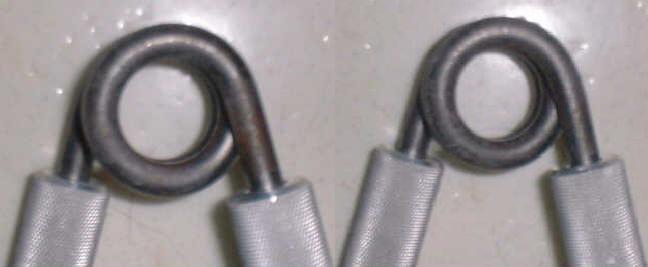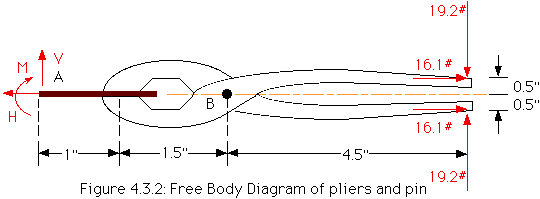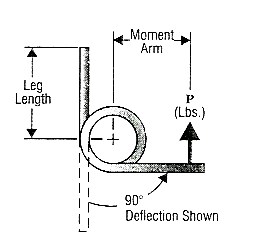Myths and Misconceptions About Heavy Hand Grippers
By Joe Weir
There are A LOT of myths, rumors, theories, etc. regarding grippers and just about all of them are rooted in the spring itself. Just like the title says, we’ll be taking a look at torsion springs, the dog leg and ‘handedness’ (left handed vs right handed grippers).
Recommended: IronMind Captains of Crush Grippers
Gripper might seem like all fun and games but I’m warning you, in order for me to disprove these myths I’m going to have to get very mean. I am going to have to absolutely destroy these things. There can be no shadow of a doubt that these have been disproven. For this to happen I am going to have to use an OBSCENE amount of physics. We all know that physics is absolutely full of confusing jargon and I’m going to have to go down that road. It won’t be pretty and it might hurt our heads a little (or a lot) but by the time we’re through you will know the truth. So let’s begin!
All the myths and misconceptions aren’t surprising because grippers, by necessity, are not symmetrical. We almost always equate anti-symmetry to a difference in structural capacity. In this case, if we see that one part of the gripper looks a bit different than its counterpart, we think this means a variation in resistance. Psychology also plays a role because if we think something is slightly different and we have physical evidence that, seemingly, supports our claim we can justify this behavior. However, this is all analogous to being right for the wrong reasons, except in this case we’re wrong for the wrong reasons.

Grippers are Torsion Springs
Although they are technically Helical Torsion Springs, we’ll stick with torsion spring because it saves me from writing helical all the time. There are other torsion springs, such as torsion bars in the suspension of a car, that are flat or other non helical shapes but the main reason for the distinction is that typical torsion springs are subjected to shearing stress whereas helical springs are subjected to a bending stress.
Torsion springs, for grippers, are made from round or square wire that is initially straight. The end of the wire is held in place while a force (in the normal direction of the wire) is applied which bends the wire into its helical shape. As a result of this process, the end that was held in place has a straighter leg than the leg of the last turn (coil), this is referred to as the dog leg of the gripper. The spring can be a left-hand bend or a right-hand bend (we’ll come to this later).
Just about every torsion spring works the same. A force is applied at a given moment arm and a torque is the resultant. This torque is applied to the spring causing it to twist about its axis and wind TIGHTER. If you take your gripper and look at the spring while you close it, you can see that the spring is tightening as if you’re trying to put another coil in it.
The spring of a gripper is all made from the same steel, the same diameter wire, therefore their torsion elastic modulus is constant. Meaning they have a linear relationship between the applied torque and the amount the spring rotates. In layman’s terms, the more the spring twists the more you have to squeeze which is why it is easier to close a gripper a little bit but very hard to close it fully, even though your hand has a mechanical advantage the more it closes.
Armed with this information, confusing though it is, we are now ready to begin debunking some myths and misconceptions.
The Dog Leg Myth
The origin of this myth is very difficult to find, in fact, I looked for quite a while and found nothing except information on setting, IronMind’s view, a few YouTube videos, and my last article.
See How to Set a COC Gripper or Other Heavy Gripper
In case you’re wondering what a dog leg is or what it looks like, you may find the following image helpful.

As far as I can tell the myth started because someone noticed one bend in the spring was different from the other. Like I said earlier, this most likely led to that individual thinking that there might be a difference in the gripper’s resistance/difficulty depending on where it was placed. Throw in some demand characteristics, or maybe a bit less fatigue, and all of a sudden the gripper is easier to close with the dog leg in the palm of the hand. Implying, therefore, that the gripper’s resistance is not the same for both handles. In other words, handle one (dog leg) takes X amount of force to move and handle two takes Y amount to move.
I’m going to try and debunk this one a few different way,s. However each one will be standalone proof that is it not true.
1) Take a piece of string, grab each end and pull it taught. Now pull a bit harder with the right hand while maintaining the same level of tension (‘tautness’) with your left hand. If you did it correctly then the string moved in the direction your right hand was pulling while it was maintaining tension. This is Newton’s second law, F=M.a.. Because you pulled harder with your right hand, your left hand and the string accelerated along with your right hand.
When you’re closing a gripper you’re doing so because the forces generated against the handles exceeds the internal forces in the spring. However when the gripper is closed think of your fingers and palm as two support points, both applying a force such that everything remains static (ie. The sum of forces=F=M.a=0, no acceleration). If one handle required more force than another then the sum of the 2 opposing forces (assuming they are co-linear, which they are) would not equal zero and something would be accelerating, or moving. Think of it as a pair of pliers. When you squeeze something with a pair of pliers you are squeezing it equally from both jaws and exerting the same force on each handle.
Free Body Diagram of Pliers Gripping a Pin

2) Remember that part about the spring being made of steel and constant modulus something or other? Well that means that the resistance along each point of the spring is the same. Since we’re tightening a single spring made of a single material we have a uniform force to overcome. Simple physics and math says that if we have two points resisting a single force at the same distance along a symmetric axis each point will carry an equal load. Its also, as far as I can justify, a statically determinant system so the forces cannot be anything other than equal. And there’s also that thing about for every action there is an equal and opposite reaction, when you squeeze a gripper the forces are the same in both the palms and the fingers. Regardless of which handle is where you still have to overcome a uniform spring force and maintain force equilibrium (the equal and opposite thing).
3) Leverage. During my time with this myth I thought to myself maybe someone thought the dog leg was harder because its straighter for a slightly longer, umm, length (and that’s why people brace it in their palm), and what if the dog leg serves to increase your leverage, since its a bit straighter and everything. And I have also read people stating that the dog leg provides better leverage against the gripper. I have an answer for that as well.
Torsion Spring Diagram

In the above image, you can see the label “moment arm”. This is the key to my point. Because the spring is concentrically wound each coil shares the same center and because the handles are the same length and each handle has the same leg length coming into it they, therefore, have the same moment arm length. If the force is applied at the same moment arm length then the force, P, must be equal (in a direction which causes torque in the opposite direction) in order to create a moment equilibrium (in the diagram the equilibrium force for the other leg would have a magnitude of P, be perpendicular to the leg and pointing to the right). In point two I already mentioned that the spring has a uniform force and that the force is shared between the handles but I didn’t mention anything about torque or moment. And…now I have.
So go ahead and use your grippers, dog leg in your palm, dog leg in your fingers, dog leg on your dog, it doesn’t matter one tiny bit.
The Handedness Myth
Along the same idea of the dogleg comes the myth that grippers are hand specific. Meaning a left-handed gripper is different from a right-hand gripper. This is incorrect and all stems from the winding (remember that right hand/left hand stuff from earlier). To tell if a winding is left or right handed you hold the body of it by placing your fingers around the coil. If the coil ends in the direction that your fingers are going AND your thumb is facing upwards, the winding is ‘that’ hand. So for an IronMind CoC, it is a left-hand winding. This doesn’t mean you can’t have a gripper with a right hand winding as a right-hand winding will still function the same (ie tightening mechanism).
I suspect that the myth started when someone associated a left-hand winding as being a left-handed gripper. I have also read people saying that you should place the dogleg in your palm for the right hand and in your fingers for the left because the winding is reversed. I personally still cannot make sense of that statement, but it’s been a long day for me.
Again if we go back to the previous sections, the spring is wound such that it always tightens. Regardless of which handle is where or even if you invert the gripper, squeezing the handles together will always cause the spring to tighten. I can think of no circumstances and have come across no concrete reasons as to why grippers are not transferable between hands. The only way it may not work is if the handles are ergonomic and change your gripping position or if you try to pull the gripper handles away from each other whenever you train your other hand.
IronMind reports that they receive quite a few emails from people who actually request a set of left-handed grippers, and now you don’t have to worry about being one of those people.
I hope that by now you realize the fallacies of these myths and that you will help thwart them everywhere you go. IronMind supports all of the conclusions that I have made through their own manufacturing and experimental work, but since they simply state facts without any detailed explanation I have merely attempted to provide the physics and logic behind their statements.
See also The Gripper Guide Part 2 for more discussion of gripper handedness and other important information.
